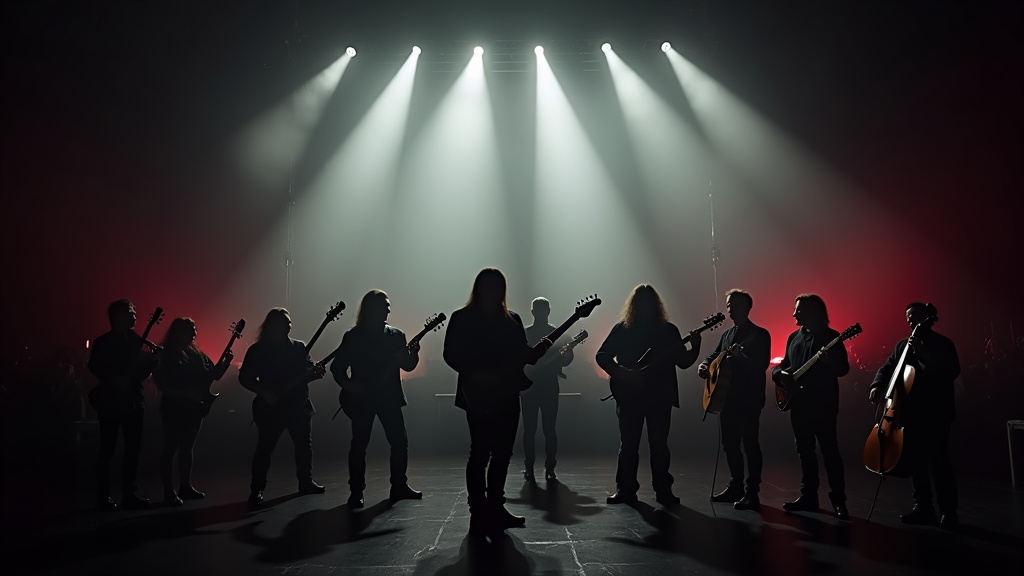If you’ve followed the world of symphonic metal for even a short while, you’ve probably noticed how the genre always seems to mix it up and reinvent itself while keeping those signature bold melodies and orchestral swells. These days, symphonic metal is definitely on the move, with fresh sounds and artists shaking things up. Here, I’ll guide you through some big trends shaping the future and introduce a few new bands and musicians that are making waves.

What’s New in Symphonic Metal?
Symphonic metal got its start by mixing heavy metal guitars with classical music vibes. Not just borrowing a few strings, but genuinely building whole songs around orchestras and epic themes. Bands like Nightwish, Epica, and Within Temptation really set the tone. Lately, it feels like the genre is stretching its boundaries even further. You’ll hear everything from folk influences to electronic elements and even progressive rock popping up in new releases these days.
Fresh ideas keep symphonic metal exciting and relevant, which is a big reason its audience has kept growing, especially in places like Europe and South America. In fact, streaming data on Spotify and YouTube (source: Statista: Most Popular Music Genres Worldwide) shows interest increasing every year. Symphonic metal tracks regularly appear in soundtracks, games, and even movie trailers. That crossover is opening the door for the next generation of fans and musicians who are itching to try something new.
Trending Sounds and Styles
From what I’m seeing and hearing, here are a few trends shaping the future of symphonic metal:
- Blending More Genres: Bands are mixing symphonic metal with everything from folk and black metal to power pop and electronica. Those mashups aren’t just for shock value. They open up totally new moods and possibilities for storytelling.
- Using Modern Orchestration: Many newer bands use digital orchestration tools, letting them experiment without hiring an entire orchestra. This leads to massive, theatrical intros and interludes, with a lot of creative freedom.
- Bolder Visuals and Performances: Live shows are bigger and more cinematic, featuring light shows and costume changes. Some groups, especially in Europe, tour with full live choirs or string sections for the full effect.
- Expanding Lyrical Themes: Instead of sticking only to fantasy or historical topics, today’s artists often get into science fiction, mythology from non-European cultures, or even social issues, giving the music more depth and variety.
All of this makes symphonic metal feel really fresh without losing any of its punch.
Up-and-Coming Artists to Watch
I’ve been keeping an eye on several emerging acts doing next-level cool things in the symphonic metal world. Here are just a few you might want to keep on your radar:
- Ad Infinitum (Switzerland): Their sound is epic and gothic, but with catchy choruses and modern production. Lead vocalist Melissa Bonny has a strong classical and metal background. Their 2023 album “Chapter III: Downfall” has caught a lot of positive buzz.
- Beyond the Black (Germany): They blur the lines between power metal, pop, and symphonic elements. Their latest releases are super accessible for new fans while still satisfying longtime genre lovers.
- Ignea (Ukraine): Mixing Middle Eastern scales, metal riffs, and symphonic arrangements, Ignea brings storytelling from Slavic folklore and modern topics together in a way that feels both exotic and relatable.
- Illumishade (Switzerland): Founded by members of Eluveitie, Illumishade builds huge soundscapes with cinematic vibes. Their debut “Eclipse” pulls together both electronic and orchestral layers for a sound that feels very modern.
All of these artists show how much variety you can find in the genre and how there’s really something for everyone—whether you want drama, melody, or just shredding guitar solos backed by a full choir.
How Technology Is Changing Symphonic Metal
Tech has always mattered in music, but it seems extra important in today’s symphonic metal scene. Here are a few ways new tools are letting bands get creative:
- Sampling Libraries and Virtual Instruments: Software like Spitfire Audio and Vienna Symphonic Library let artists put together convincing orchestral sections entirely on their laptop. Even small bands or solo artists can afford the sweeping, cinematic sound that’s usually expensive to create.
- Home Studios and Online Collaboration: With powerful recording tools at home, musicians can record, mix, and share projects globally without meeting face-to-face. You’ll often find guest artists recording vocal or instrumental parts from another country.
- Streaming and Social Platforms: YouTube, Bandcamp, and Twitch aren’t just for music releases. Artists are hosting Q&A sessions, live “studio cams,” and behind-the-scenes documentaries, bringing fans closer to the whole creative process.
This tech-driven approach has lowered the barrier for entry. You now see musicians from regions where there wasn’t a scene before building their own symphonic metal followings.
What New Fans Are Looking For
It’s not just the artists driving change—fans have higher expectations with everything available on demand. Listeners want more than just great studio albums. They’re drawn to:
- Immersive Music Videos: HD music videos with cinematic storytelling are everywhere. Many newer bands produce fully animated or narrative-driven clips that expand on their songs’ themes and characters.
- Accessible Live Content: With livestreaming tech, even small bands can put on professional, multiview concerts or listening parties right from their home studios.
- Deeper Community Engagement: Through Discord, Patreon, or even custom apps, artists let superfans backstage with exclusive demos, voting on setlists, or even team up on lyrics or album art.
All these trends really help build active, connected communities, which gives the music extra staying power.
Challenges Facing Symphonic Metal
While the genre is growing, a few hurdles still exist. I’ve noticed that:
- Producing Orchestral Parts Is Still Pricey: Even with new software, arranging and mixing symphonic layers takes a ton of time and skill. Getting a real orchestra is even tougher, so some indie bands rely on Patreon and crowdfunding.
- Standing Out in a Crowded Field: With genre-mixing so common, it’s easy for new acts to sound similar, which means bands must push harder to develop their own voice.
- Touring Costs: Bringing extra musicians or gear on tour means higher costs. It’s common to see “hybrid” shows with some parts played live and others handled by backing tracks to keep expenses manageable.
Cost of Symphonic Elements
Recording with a full orchestra isn’t cheap. Modern software helps, but serious bands sometimes partner with local or national orchestras for special projects, which takes months of planning and cooperation. Some artists offset these costs by launching behind-the-scenes documentary series, special edition albums, or VIP concert experiences for fans ready to pay a little extra for something unique.
Developing a Distinctive Sound
It’s important for younger bands to pay attention to what makes their music unique—whether that’s in vocal style, arrangement, or even their stage persona. The most memorable groups I’ve found are the ones that build real personalities and worlds around their albums, drawing fans into a full experience rather than just a setlist.
Tour Logistics
Creative live approaches help keep things affordable. Some bands use local classical musicians in each city instead of traveling with a full orchestra. Others prerecord certain orchestral sections, freeing up cash and letting them put extra energy into the stage show.
None of these challenges are show-stoppers. It takes a lot of hustle and creativity for up-and-coming artists to make their voices heard, but the rewards can be huge.
Tips for Stumbling Upon New Symphonic Metal
Curious about getting deeper into the changing world of symphonic metal? Here are a few easy ways to start:
- Follow Streaming Playlists: Spotify and Apple Music feature curated symphonic metal playlists mixing classic and new tracks. These are updated regularly and spotlight breakout acts.
- Explore Bandcamp and YouTube: Smaller artists often post full albums, lyric videos, or live clips for free. It’s an awesome way to find music without algorithms narrowing your choices.
- Check Out Fan Forums: Places like Reddit’s r/symphonicmetal and Discord servers regularly highlight new releases, fan-made recommendations, and unique live show reviews you won’t spot anywhere else.
I’ve stumbled upon some amazing bands this way. Digging around always leads to fresh finds.
Frequently Asked Questions
Below are a few questions I hear from folks just getting into symphonic metal, plus my thoughts:
Question: Is symphonic metal the same as gothic metal or power metal?
Answer: Not quite. Symphonic metal’s main thing is using real or digital orchestral sounds on top of metal. Gothic and power metal might share some elements, but focus more on different themes or musical techniques.
Question: Can solo artists create symphonic metal, or do you need a full band?
Answer: Plenty of solo projects exist, especially with the quality of orchestral samples and digital audio workstations today. Songwriters can compose, record, and produce entire albums from home before bringing in guest musicians or vocalists as needed.
Question: What equipment/software do new symphonic metal artists use?
Answer: Tools like Cubase, Logic Pro, and FL Studio are all popular, along with sample libraries for orchestras, choirs, and synths. Many artists also put to work guitar amp modeling and effects plugins for that perfect mix of heavy and symphonic.
Where Symphonic Metal Goes from Here
The future of symphonic metal looks really promising. Creative risks and young talent aren’t afraid to shake things up. From what I’ve experienced, it’s a genre always searching for new ways to mix stories, sounds, and technology, staying just ahead of the curve. Whether you’re already hooked or just tuning in, there’s honestly never been a better time to track down your next favorite band or album in the world of symphonic metal.
Go ahead and check out some of these trends, jump in with new artists, and see where this bold and often beautiful genre is heading next!
